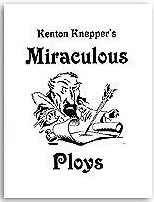Miraculous Ploys
Kenton Knepper
The Wonder Wizards
(Based on 1 review)

Click on a dealer below to buy
Miraculous Ploys Today!
Contents Include:
* Stirring: A spectator suddenly cannot make a simple stir straw spin on a table. What once seemed easy is now impossible due to suggestion. No gimmicks, just some great secrets.
* The Spirit Pen: A pen stands up on paper and writes what a spectator thinks. The BEST and easiest version ever. Nothing to make. Costs next to nothing... You probably own the needed prop already. The FULL version finally explained here.
* Chill: The performer makes the spectator feel cool, and then colder still, by stroking his hand or face and using apparent hypnotic methods. This is a classic Kentonism effect and many variations are included. GREAT stuff.
* Touched in the Head: The performer mimes scratching above a spectator's head, and the spectator feels his head get scratched. No, no loops or gimmicks. The performer holds his hands over the spectator who swears he feels "something". Weerd magic and suggestion worthy of the real thing. Impromptu.
And Many More!
Reviews
(Top ▲)
The 42 pages of material in Kenton Knepper's Miraculous Ploys runs quite a gamut, but overall I found it only partially satisfying. One reason for this is that book could have benefitted from more attention to editing and organization. Portions of it are repetitive, and it isn't until page 24 that Knepper attends to a key concept; that much of this material is based on bold ploys (hence the name) and, the author contends, is best learned by trying it for yourself. That's all well and good, but it should have been stated in the introduction, as it very much sets the tone for the whole publication.
While there are several effects in this book (about 10, depending on how you count variations) its flavor is more like an extended lecture instead of an instructional book. You won't find step-by-step procedures, materials lists, or many meaningful illustrations. If there's a piece you want to adopt, you'll have to read the stream-of-consciousness discussion a few times to be sure that you've gotten a good view of how the routine is constructed. Also, be prepared for a bit of detective work in many cases. For example, "The Weight of Thought" describes several different types of psychometric bags that you can make, but they're reliant upon fabrics that have very specific qualities, and there's little to help you efficiently find what you need in a fabric or craft store. You'll just have to dig and hope that you get lucky. (You'll also have to hope that the conditions at your performing venue are right as some of the bags rely on lighting conditions to work effectively.)
Likewise, in "Patterns in a Rainbow Mind" you'll need to assemble a one-way forcing deck with each card having a different and "colorful" back. Oh, except for a few cards, which need back designs that contain meaningful imagery. (Knepper suggests Racing Car and Fish-themed back designs.) It's a decent trick, and I like the simple handling, but you're probably better off buying the standalone version to save yourself the work of assembling the deck.
Be aware that two of the effects that are highlighted in the dealer description, "Chill" and "Touched in the Head", are not only quite bold and rely on Knepper's trademark "dual-reality" positioning, they require you to repeatedly violate your audience member's personal space. For example, here are excerpts from the discussion of Chill:
"I am still standing behind the spectator. I reach my right hand to his right ear, left hand to his left. The thumbs of both hands go behind his ears, to the backside of each ear. It's a sensitive spot behind the ear, so thats where [...] I rub my thumb back and forth just a little there. [...] I bring both hands together at the middle of the spectator's forehead. Now my right thumb touches his forehead for a beat or two. I stroke his forehead with both hands, moving my hands apart, and then bringing them back together again."
Wow. Aside from the gambit (ie: ploy) that the method relies on, you'll need to convince your audience that this is a "Tibetan body temperature experiment" that you're demonstrating and you're not just manhandling someone's head. More power to you if you can pull it off; I'm uncomfortable just reading about it.
I do wish that Knepper was more liberal with crediting others and that he would provide references to other works so that an interested student has more to pursue. As it is, even references to his own previous work are left frustratingly vague and incomplete. I think this is a missed opportunity as there are several effects that would benefit from a bit more detail and information about their history.
Knepper closes the book with a 7 page essay that was, for me, the highlight of the book. In it he implores performers to find their own path in magic and ensure that each audience interaction is filled with good intention and enchanting moments. (Forehead massages, aside.) Like the rest of the book, the essay could be improved with further editing and refinement, but it stands out because of its sincere voice and important message. After reading 32 pages or so of "Kentonistic" language, this essay is a breath of fresh air and seems to come from deeper within. I hope he offers more like this in future works.
The bottom line is if you're already familiar with Knepper's material and approach, or you enjoyed 7 Deceptions, then you'll likely find this publication to be a fair value. But if you're looking to get your first sample of "Kentonism," you're better off with Wonder Words, which has more meat and general applicability.
While there are several effects in this book (about 10, depending on how you count variations) its flavor is more like an extended lecture instead of an instructional book. You won't find step-by-step procedures, materials lists, or many meaningful illustrations. If there's a piece you want to adopt, you'll have to read the stream-of-consciousness discussion a few times to be sure that you've gotten a good view of how the routine is constructed. Also, be prepared for a bit of detective work in many cases. For example, "The Weight of Thought" describes several different types of psychometric bags that you can make, but they're reliant upon fabrics that have very specific qualities, and there's little to help you efficiently find what you need in a fabric or craft store. You'll just have to dig and hope that you get lucky. (You'll also have to hope that the conditions at your performing venue are right as some of the bags rely on lighting conditions to work effectively.)
Likewise, in "Patterns in a Rainbow Mind" you'll need to assemble a one-way forcing deck with each card having a different and "colorful" back. Oh, except for a few cards, which need back designs that contain meaningful imagery. (Knepper suggests Racing Car and Fish-themed back designs.) It's a decent trick, and I like the simple handling, but you're probably better off buying the standalone version to save yourself the work of assembling the deck.
Be aware that two of the effects that are highlighted in the dealer description, "Chill" and "Touched in the Head", are not only quite bold and rely on Knepper's trademark "dual-reality" positioning, they require you to repeatedly violate your audience member's personal space. For example, here are excerpts from the discussion of Chill:
"I am still standing behind the spectator. I reach my right hand to his right ear, left hand to his left. The thumbs of both hands go behind his ears, to the backside of each ear. It's a sensitive spot behind the ear, so thats where [...] I rub my thumb back and forth just a little there. [...] I bring both hands together at the middle of the spectator's forehead. Now my right thumb touches his forehead for a beat or two. I stroke his forehead with both hands, moving my hands apart, and then bringing them back together again."
Wow. Aside from the gambit (ie: ploy) that the method relies on, you'll need to convince your audience that this is a "Tibetan body temperature experiment" that you're demonstrating and you're not just manhandling someone's head. More power to you if you can pull it off; I'm uncomfortable just reading about it.
I do wish that Knepper was more liberal with crediting others and that he would provide references to other works so that an interested student has more to pursue. As it is, even references to his own previous work are left frustratingly vague and incomplete. I think this is a missed opportunity as there are several effects that would benefit from a bit more detail and information about their history.
Knepper closes the book with a 7 page essay that was, for me, the highlight of the book. In it he implores performers to find their own path in magic and ensure that each audience interaction is filled with good intention and enchanting moments. (Forehead massages, aside.) Like the rest of the book, the essay could be improved with further editing and refinement, but it stands out because of its sincere voice and important message. After reading 32 pages or so of "Kentonistic" language, this essay is a breath of fresh air and seems to come from deeper within. I hope he offers more like this in future works.
The bottom line is if you're already familiar with Knepper's material and approach, or you enjoyed 7 Deceptions, then you'll likely find this publication to be a fair value. But if you're looking to get your first sample of "Kentonism," you're better off with Wonder Words, which has more meat and general applicability.









